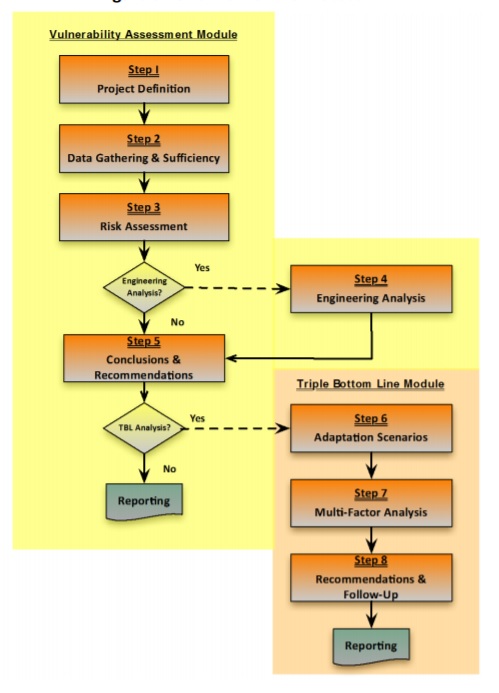Engineers are responsible for planning, designing, operating, maintaining and managing public infrastructure. It is critical for engineers to understand and account for the risks and vulnerabilities to this infrastructure that is resulting from the increasing frequency of extreme weather conditions and our changing climate.
The PIEVC Protocol
In Canada, there are a number of tools available to assist with identifying climate change impacts. One of the most robust tools currently available, the PIEVC Protocol, has been applied to assess climate risks and vulnerabilities across a wide range of infrastructure systems in Canada including: buildings, storm water/wastewater systems, roads and associated infrastructure, water supply and management systems, electricity distribution and airport infrastructure. The Public Infrastructure Engineering Vulnerability Committee (PIEVC) Protocol was created by Engineers Canada, in partnership with Natural Resources Canada (NRCan). It is a well-structured and widely supported process that systematically assesses the risks of extreme weather and future climate changes on public infrastructure to allow for the better planning and design of safe and climate-resilient infrastructure. Application of the PIEVC Protocol can identify risks, highlight areas to protect, build strong communities, save municipalities money, and safeguard the environment.
The Challenge: Climate Change
Climate change and extreme weather events are exposing transit infrastructure to impacts it was not originally designed to withstand. This exposure can reduce the lifespan of transit infrastructure components, and cause disruptions to the travelling public. Extreme weather events such as increased temperatures, increased severity of precipitation, higher wind gusts, and increased freezing rain, can create possible risks to public health, safety, the environment, and revenue losses from infrastructure change and destruction.

The Solution: Vulnerability Assessments Using the PIEVC Protocol
The PIEVC Protocol process is applied to individual infrastructure assets such as buildings or an infrastructure system. It is designed to document current and future climate risks to infrastructure.
To understand the possible vulnerabilities of a system, historical climate information is systematically reviewed and the nature, severity and probability of potential future climate changes and events is projected. The protocol establishes the adaptive capacity of an infrastructure component, based on its design, operation and maintenance. To identify higher risk components and the nature of the threat from the climate change impact, the protocol estimates the severity of climate impacts on infrastructure components (i.e. deterioration, damage, destruction.) This information can be used by stakeholders to make informed decisions about which infrastructure components are most vulnerable and require adaption, as well as how to adapt those assets (i.e. design adjustments, changes to operational or maintenance procedures).
A Five Step Process
The PIEVC Protocol is a five-step process. It provides a procedure for sifting through data for developing relevant information on specific elements of the climate and characteristics of a given infrastructure. The Protocol then considers how this information might interact and result in the infrastructure being vulnerable or adaptive to climate change.
- Define Project. Develop a general description of the infrastructure.
- Data Gathering & Sufficiency. What infrastructure assets will be assessed and the particular climate factors that will be considered.
- Risk Assessment. Identify the interactions between the infrastructure, the climate and other factors that could lead to vulnerability.
- Engineering Analysis. Conduct focused engineering analysis on climate/infrastructure interactions requiring further assessment.
- Conclusions & Recommendations. Establish risk mitigation alternatives and recommendations that balance a range of technical, social, environmental and economic factors.

Benefits of Using the PIEVC Protocol for Transit Infrastructure
The tool has the potential to help large and small transit organizations adapt their particular infrastructures to a changing climate. It is effective at engaging engineers to work closely with other professionals to support the planning, operation, maintenance, management and use of the infrastructure to the benefit of both the organization and community.
The Protocol enables organizations to establish a climate risk and vulnerability profile and to understand the true key risks to their systems. Having an understanding of how climate change is going to impact the infrastructure over its life-cycle will help experts evaluate the type of impacts and their magnitude, and define how to address them in the asset-management process.
The results from conducting a climate vulnerability assessment using the PIEVC protocol appear to inform project stakeholders enough to aid in the development of cost effective recommendations that adapt the highest risk components to improve their resilience to climate impacts.
The Future of the PIEVIC Protocol
The PIEVC Protocol has now been applied to more than 50 infrastructure asset projects across Canada, in Costa Rica and Honduras. The Protocol has been applied to the design of new infrastructure and for the rehabilitation or retrofit of existing infrastructure. The results of the process inform not only engineers but also planners, managers and operators to improve their understanding and management of the impacts and risks that public infrastructure faces with our changing climate.
In Canada, the Protocol has captured the attention of various Governments, including Transport Canada, British Columbia Ministry of Transportation and the Province of Ontario, which have all referenced the Protocol in guidance documentation for considering climate change impacts. Various cities, municipalities and transit organizations have begun to implement climate vulnerability assessment frameworks based on the PIEVC Protocol, including Metrolinx as part of their Metrolinx Five Year Strategy (2015-2020).
The PIEVC Protocol is one method accepted by the Infrastructure Canada Climate Lens to fulfill the climate adaptation considerations for funding infrastructure investments.
Ask our Experts
We conduct vulnerability and resiliency assessments to determine exactly where and what operations/ elements of your system are most vulnerable. The output of this exercise will provide data allowing you to perform an initial risk assessment for each operation or component of your transit system.
For more information on how we can help with your vulnerability and resiliency assessment requirements, please visit our Climate Resilience webpage or contact:
 Jim Teeple, Principal, Practice Lead, Transit Operations & Maintenance
Jim Teeple, Principal, Practice Lead, Transit Operations & Maintenance
416-499-3110 x1011224
 Andrew Harkness, Director, Environmental
Andrew Harkness, Director, Environmental
613-739-2910 x1022258

